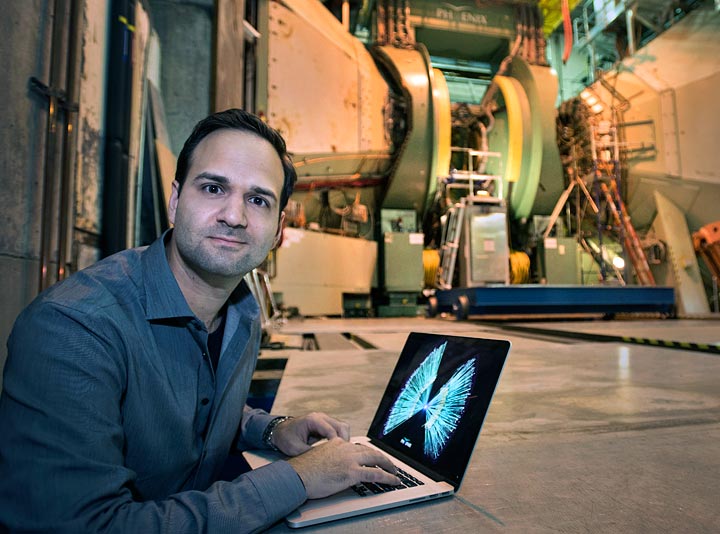508th Brookhaven Lecture on Wednesday, 10/21: 'Using Nuclei to Catch Shape-Shifting Protons in the Act: One Hypothesis, Two Colliders'
October 21, 2015
Of all the atomic matter in our universe—from molecules in the exotic materials probed for research at Brookhaven Lab to far off stars not yet seen—99.9 percent of it all is composed of nuclei containing protons and neutrons.
Scientists have known the average sizes of these atomic building blocks for more than 50 years. Now, however, they know that a proton's actual size fluctuates continuously, because of constant interactions among the smaller, subatomic particles called quarks and gluons found inside each proton.
At the world's two operating particle colliders, the Relativistic Heavy Ion Collider (RHIC) at Brookhaven Lab and Large Hadron Collider (LHC) at CERN in Europe, scientists often collide protons with much larger nuclei like gold and lead to learn more about how quarks and gluons interact inside those large, dense nuclei. Within the last few years, some scientists have begun analyzing data from the two colliders using large nuclei to learn more about protons, how protons can have different sizes and shapes each time you look at them depending on how their quarks and gluons are arranged, and more.
Join Dennis Perepelitsa of Brookhaven Lab's Physics Department for the 508th Brookhaven Lecture, titled "Using Nuclei to Catch Shape-Shifting Protons in the Act: One Hypothesis, Two Colliders," in Berkner Hall at 4 p.m. on Wednesday, Oct. 21. All are invited to attend this free talk, which is open to the public. Refreshments will be offered before and after the lecture. Visitors to the Lab 16 and older must carry a photo ID while on site. Add to calendar
Perepelitsa will begin this Brookhaven Lecture by introducing his hypothesis that protons with most of their energy concentrated in single quarks or gluons are particularly small and shaped differently too—more like an arrow than a sphere. He will then describe how his analysis of data from particle collisions at RHIC and the LHC are being used to test his hypothesis.
To join Perepelitsa for dinner at a restaurant off site after the talk, contact Mariette Faulkner (Ext. 4064 or faulkner@bnl.gov).
About the Speaker
Perepelitsa joined the Physics Department at Brookhaven Lab as a Goldhaber Postdoctoral Fellow in 2013. The prestigious Goldhaber Distinguished Fellowship—funded by Brookhaven Science Associates, the company that manages Brookhaven Lab for the U.S. Department of Energy—is awarded to candidates with exceptional talent and credentials who have a strong desire for independent research at the frontiers of their fields.
Before arriving at Brookhaven Lab, Perepelitsa earned bachelor's degrees in physics and mathematics with computer science at Massachusetts Institute of Technology in 2008. At Columbia University, he earned a master's degree in 2010, a master's of philosophy in 2012, and a Ph.D. in 2014—all in physics. Perepelitsa has been recognized with several awards and recognitions in addition to the Goldhaber Fellowship, and he is the first scientist to earn outstanding Ph.D. thesis awards from research communities at RHIC and the LHC.
2015-5986 | INT/EXT | Newsroom










